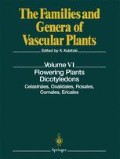Abstract
Perennial insect-trapping evergreen woody shrubs from a taproot with limited lateral root development; stems perennial, erect and few-branched. Leaves alternate, crowded apically, linear to tapering, exstipulate, margins entire or with short lateral linear lobes, with insect-trapping stalked glands. Flowers in terminal, few-flowered botryoids, hermaphroditic, medium-sized and showy; calyx and corolla 5-merous, well developed; perianth actinomorphic, free, rotate, bright purple, reddish pink or white; petals imbricate in bud; stamens 5, opposite the sepals; anthers hypogynous; filaments free, filiform; anthers sub-basifixed, 2-thecate, 4sporangiate, introrse, incurved in bud, subtended by a basal swelling containing a nectariferous cavity, irritable and swinging up when touched at anthesis to become erect, dehiscing by four short apical pores or slits; gynoecium of three united carpels; ovary superior, 3-locular with axile placentation; ovules anatropous, unitegmic, solitary or 2–4 per locule; style terminal, tapering with a small capitate stigma or expanding terminally with an obconical stigma, papillate, erect. Fruit a smooth loculicidal, 3-valved cartilaginous capsule. Seeds exotestal, small, ellipsoid and smoothly reticulate or angular-trilete and prominently warty or honeycomb-sculptured, dark reddish-brown; endosperm copious; embryo linear.
Access this chapter
Tax calculation will be finalised at checkout
Purchases are for personal use only
Preview
Unable to display preview. Download preview PDF.
Bibliography
Albert, V.A., Williams, S.E., Chase, M.W. 1992. Carnivorous plants: phylogeny and structural evolution. Science 257: 1491–1495.
APG (Angiosperm Phylogeny Group) 1998. See general references.
Behnke, H.-D. 1991. See general references.
Bentham, G., Hooker, J.D. 1865. Genera Plantarum vol. I. London: L. Reeve.
Bruce, A.N. 1907. On the distribution of the tentacles of Roridula. Notes Roy. Bot. Gard. Edinburgh 17: 83–98.
Carlquist, S. 1976. Wood anatomy of Roridulaceae: ecological and phylogenetic implications. Am. J. Bot. 63: 1003–1008.
Chrtek, J., Slavílcovâ, Z., Studnicka, M. 1989. Beitrag zur Leitbündelanordnung in den Kronblättern von ausgewählten Arten der fleischfressenden Pflanzen. Preslia 61: 107–124.
Conran, J.G., Dowd, J.W. 1994. The phylogenetic relationships of the Byblis-Roridula (Byblidaceae-Roridulaceae) complex inferred from 18 S rRNA partial sequences. Plant Syst. Evol. 188: 73–86.
Cronquist, A. 1981. See general references.
Dahlgren, R.M.T., van Wyk, A.E. 1988. Structures and relationships of families endemic to, or centered in Southern Africa. Monogr. Syst. Bot. Missouri Bot. Gard. 25: 1–94.
Diels, L. 1930. Roridulaceae. In: Engler, A., Prantl, K. Die natürlichen Pflanzenfamilien ed. 2, 18a. Leipzig: W. Engelmann, pp. 346–348.
Ellis, A.G., Midgley, J.J. 1996. A new plant-animal mutualism involving a plant with sticky leaves and a resident Hemipteran insect. Oecologia 106: 478–481.
Erdtman, G. 1952. See general references.
Fenner, C.A. 1904. Beiträge zur Kenntnis der Anatomie, Entwicklungsgeschichte und Biologie der Laubblätter und Drüsen einiger Insectivoren. Flora 93: 335–434.
Hallier, H. 1912. L’origine et le système phylétique des angiospermes. Arch. Neerl. Sci. Exactes Nat., III. B 1: 146–234.
Hutchinson, J. 1959. The families of flowering plants. Vol. 2. Monocotyledons, 2nd edn. Oxford: Clarendon Press.
Jensen, S.R., Nielsen, B.J., Dahlgren, R. 1975. Iridoid compounds, their occurrence and systematic importance in the angiosperms. Bot. Not. 128: 148–180.
Joel, D.M., Juniper, B.E., Dafni, A. 1985. UV patterns in the traps of carnivorous plants. New Phytol. 101: 585–594.
Juniper, B.E., Robins, R.J., Joel, D.M. 1989. Carnivorous plants. London: Academic Press.
Kress, A. 1970. Zytotaxonomische Untersuchungen an einigen Insektenfängern (Droseraceae, Byblidaceae, Cephalotaceae, Roridulaceae, Sarraceniaceae). Ber. Deutsch Bot. Ges. 83: 55–62.
Lloyd, F.M. 1934. Is Roridula a carnivorous plant? Can. J. Res. 10: 780–786.
Lloyd, F.M. 1942. The carnivorous plants, 2nd edn. Waltham, Mass.: Chronica Botanica Co.
Marloth, R. 1903. Some recent observations on the biology of Roridula. Ann. Bot. 17: 151–157.
Marloth, R. 1910. Further observations on the biology of Roridula. Trans. Roy. Soc. S. Afr. 2: 59–61.
Marloth, R. 1925. Roridulaceae. In: The Flora of South Africa vol. 2, part I. Cape Town: Darter Bros., pp. 26–30.
Midgley, J.J., Stock, W.D. 1998. Natural abundance of Delta N-15 confirms insectivorous habit of Roridula gorgonias, despite it having no proteolytic enzymes. Ann. Bot. 82: 387–388.
Obermeyer, A.A. 1970. Roridulaceae. In: Codd, L.E., DeWinter, B., Killick, D.J.B., Rycroft, H.B. (eds.) Flora of Southern Africa, vol. 13. Pretoria: National Botanical Institute, pp. 201–204.
Peng, C.-I., Goldblatt, P. 1983. Confirmation of the chromosome number in Cephalotaceae and Roridulaceae. Ann. Missouri Bot. Gard. 70: 197–198.
Planchon, J.É. 1848. Sur la famille des Droséracées. Ann. Sci. Nat. Bot. III, 9: 79–99.
Solereder, H. 1908. Systematic anatomy of the Dicotyledons. Vol. 1, Introduction, Polypetalae and Gamopetalae. Oxford: Clarendon Press.
Takhtajan, A.L. 1987. Systema Magnoliofitorum. Leningrad: Nauka (in Russian).
Vani-Hardev, 1972. Systematic embryology of Roridula gorgonias Planch. Beitr. Biol. Pflanzen 48. 339–351.
Zenk, M.H., Fürbringer, M., Steglich, W. 1969. Occurrence and distribution of 7-methyljuglone and plumbagin in the Droseraceae. Phytochemistry 8: 2199–2200.
Editor information
Editors and Affiliations
Rights and permissions
Copyright information
© 2004 Springer-Verlag Berlin Heidelberg
About this chapter
Cite this chapter
Conran, J.G. (2004). Roridulaceae. In: Kubitzki, K. (eds) Flowering Plants · Dicotyledons. The Families and Genera of Vascular Plants, vol 6. Springer, Berlin, Heidelberg. https://doi.org/10.1007/978-3-662-07257-8_38
Download citation
DOI: https://doi.org/10.1007/978-3-662-07257-8_38
Publisher Name: Springer, Berlin, Heidelberg
Print ISBN: 978-3-642-05714-4
Online ISBN: 978-3-662-07257-8
eBook Packages: Springer Book Archive

